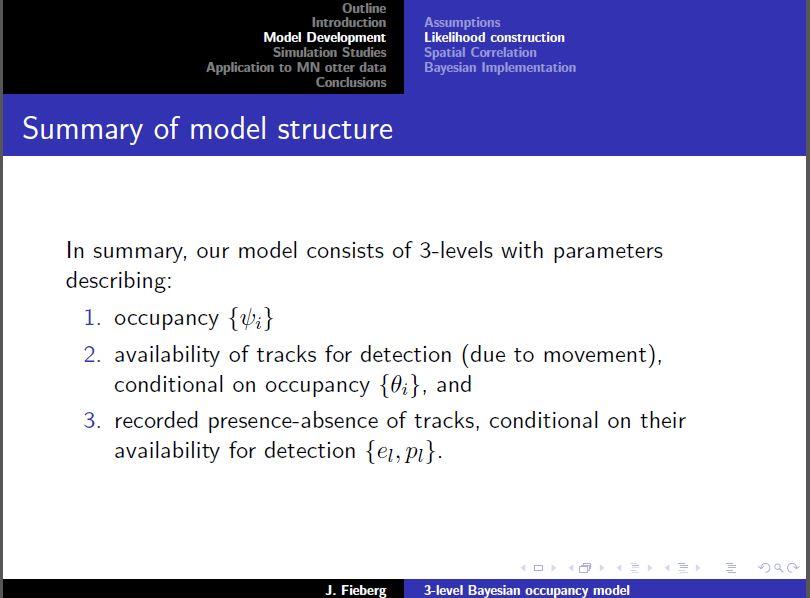I've worked on several large surveys, often in conjunction with John Guidice, the MNDNR's survey biometrician. Together, we've explored cost-precision tradeoffs involved in choosing a plot size in aerial surveys [2]. I've also worked with collaborators at Carleton College, to develop methods for modeling detection probabilities in conjunction with snow track surveys [3]. Recently, much of my time has been spent working with sightability models, including the development of a software package for program R [4]. We've applied these methods to moose in MN and mountain goats in Washington State [4-5]. In addition, we've discussed strategies for handling model uncertainty when building sightabilty models [5] and also the importance of accounting for correlation among stratum specific estimates [1]. In addition, we've recently developed a Bayesian model-based alternative that offers significant advantages when estimating trends from multi-year surveys [7, 8]. Lastly, I've worked with colleagues at the National Marine Fisheries Service to develop approaches to estimating fish abudance from underwater camera surveys [9], and I led a project aimed at developing cost-effective methods for surveying zebra mussels in newly infected lakes [10].
1. Fieberg, J. and J. G. Giudice. 2008. Variance of strati.ed survey estimators with probability of detection adjustments. Journal of Wildlife Management 72:837-844.
2. Giudice, J. G., J. R. Fieberg, M. C. Zicus, D. P. Rave, and R. G. Wright. 2010. Constructing cost and precision functions for aerial quadrat surveys: a case of ring-necked ducks in Minnesota. Journal of Wildlife Management 74:342-349.
3. Aing, C., S. Halls, K. Oken, R. Dobrow, and J. Fieberg. 2011. A Bayesian hierarchical occupancy model for track surveys conducted in a series of linear, spatially correlated sites. Journal of Applied Ecology 48:1058-1517.
4. Fieberg, J. 2012. Estimating Population Abundance Using Sightability Models: R SightabilityModel Package. Journal of Statistical Software 51:1-20.
5. Jenkins, K. J., P. J. Happe, K. F. Beirne, R. A. Ho.man, P. C. Gri.n, W. T. Baccus, and J. Fieberg. 2012. Recent population trends in mountain goats in the Olympic mountains. Northwest Science 86:264-275.
6. Giudice, J., J. Fieberg, and M. Lenarz. 2012. Spending degrees of freedom in a poor economy: a case study of building a sightability model for Moose in northeastern Minnesota. Journal of Wildlife Management 76:75-87.
7. Fieberg, J., M. Alexander, S. Tse, and K. St. Clair. 2013. Abundance estimation with sightability data: a Bayesian data augmentation approach. Methods in Ecology and Evolution 4:854–864.
8. ArchMiller, A.A.,. R. Dorazio, K. St. Clair, and J. Fieberg. 2018. Time series sightability modeling of animal populations. Plos One.
9. Shertzer, K.W., Bacheler, N.M., Coggins, L.G. Jr., and J. Fieberg. 2016. Relating trap capture to abundance: A hierarchical state-space model applied to black sea bass (Centropristis striata). ICES Journal of Marine Science 73:512-519.
